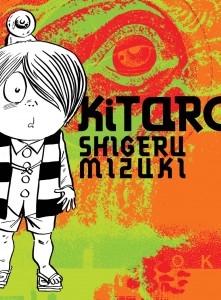By Shigeru Mizuki. Released in Japan as “Gegege no Kitaro” by Kodansha, serialized in the magazine Weekly Shonen Magazine. Released in North America by Drawn & Quarterly.
This is another of those titles manga fans have been waiting for years to see, and now Drawn & Quarterly are finally releasing what I hope is the first of multiple volumes devoted to it. Shigeru Mizuki’s most famous and influential series, about the adventures of a young yokai and his various supernatural friends, who spends much of his time investigating creepy happenings and trying to stop them. Almost all yokai manga on the market owe a debt to Kitaro, even if, on the surface, this manga is not really all that much like Kamisama Kiss or Natsume’s Book of Friends.
It starts off fairly slowly, with a few short one-shots involving Kitaro being mysterious, and a large amount of human involvement. There are some very nice scares, though, such as the story about the drunken salarymen who insult yokai at a bar and then get taught a lesson on the train ride home. These stories have Kitaro mostly on his own, which is fine for a while, but he’s pretty much a stoic straight man, so the series needs some spicing up after it gets going. Enter Nezumi Otoko (Rat Man), a yokai who is always out for himself above any other. His appearance adds a lunatic joy to the proceedings, as you’re never quite sure if he’s been possessed by evil, is changing sides merely to save his own skin, or is genuinely being a complete ass. Usually it’s all three.
As the collection goes on, the stories get longer and more complex. One tale has Kitaro and several of the stronger yokai (including future series regulars Konnaki Jiji, Sunakabe Baba, and Ittamomen) headed to an island that has been taken over by Western monsters such as Dracula and Frankenstein. At first I was expecting this to be a fairly lighthearted romp, but things got surprisingly dark and serious for our heroes. Even more impressive is the largest story in the book, which shows Kitaro joining an expedition to track down an immortal yokai monster, but being hindered (and later completely betrayed) by an egotistical young scientist who wants the credit and glory of single-handedly discovering it. What eventually happens is a giant kaiju battle, a la Godzilla. This gives us some of the best art of the series, and also has Nezumi Otoko bitchslapping the villain over and over again, something I will never get tired of reading.
Contrary to today’s hipper, sexier Shonen Magazine, the stories that ran in the 1960s version are totally child-friendly, and I think that still applies today. Younger kids may get freaked out a bit by some of the scarier things, particularly Kitaro and his father, who is an eyeball that lives in Kitaro’s own empty socket, and pops out grotesquely from time to time. For the most part, however, these are great, fast-paced ghost stories with action and laughs that any child can enjoy.
And it goes without saying that adult manga fans should enjoy this as well. It’s fairly episodic – there really aren’t any ongoing plot threads beyond ‘Kitaro discovers new yokai threat’ – but that’s mostly irrelevant. You’re here to see a good story well told, some really creepy yokai, and the work of a master craftsman in what has proven to be his greatest work. Highly recommended.


[…] (Comic Attack) Carlo Santos on vol. 1 of Dragon Ball (3-in-1 edition) (ANN) Sean Gaffney on Kitaro (A Case Suitable For Treatment) Rebecca Silverman on vol. 1 of Magi (ANN) Ash Brown on The Strange […]